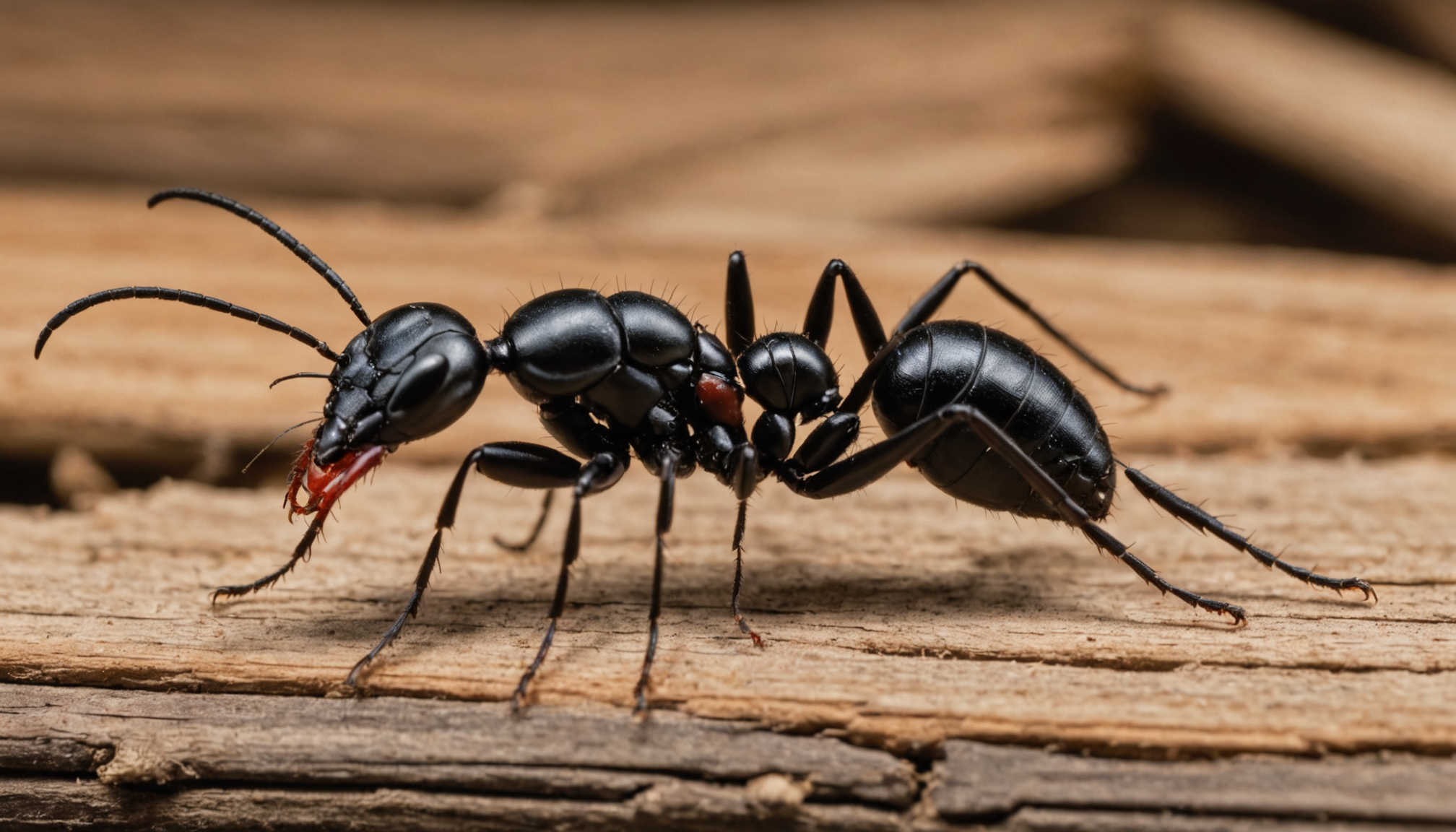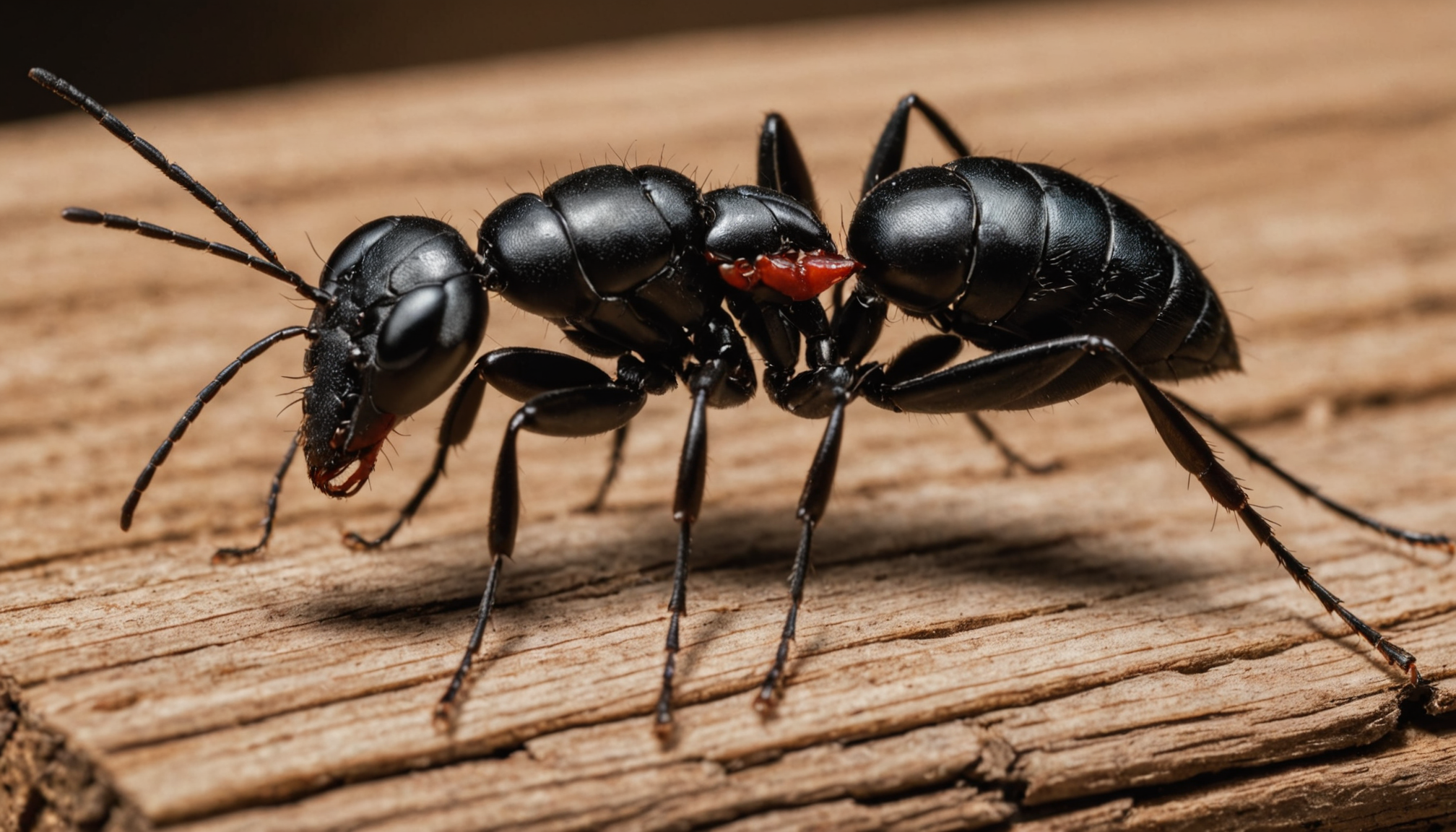Missouri homeowners often face the challenge of distinguishing between carpenter ants and termites—two prevalent pests that can cause substantial wood damage if left unchecked. While both insects pose significant threats to properties, understanding their distinct characteristics is crucial for effective identification and pest control. Knowledge of these differences not only aids in timely intervention but also prevents costly repairs and structural damage.
Firstly, size and color are key identifiers when comparing carpenter ants and termites. Carpenter ants are generally larger, with worker ants ranging from 3.5 to 13 millimeters in size. Typically black, they can also present shades of red or brown depending on the species. On the other hand, termites are generally smaller, measuring about 3 to 20 millimeters, with a uniform, pale, or creamy coloring that can make them less conspicuous.
Another crucial identifier is the structure of their bodies. Carpenter ants have a defined, pinched waist and bent antennae, traits that distinguish them from termites, which possess broad waists and straight antennae. Moreover, when considering winged variations, such as swarmers or reproductive types, carpenter ants exhibit two pairs of wings of unequal length, with the front wings larger than the hind ones, whereas termites’ wings are equal in size and shape.
In addition to physical characteristics, understanding behavioral differences between these insects is vital for accurate identification and management. Carpenter ants, contrary to popular belief, do not consume wood. Instead, they excavate it to create smooth galleries, often leading to visible piles of wood shavings or frass near their nests. This behavior can sometimes mislead homeowners into believing they have termites. Conversely, termites consume wood, causing unseen yet severe internal damage that can, over time, jeopardize structural integrity.
The lifecycle and reproductive habits of these pests further differentiate them. For instance, carpenter ants are primarily nocturnal, and their colonies can expand gradually over time, potentially reaching satellite formations. In contrast, termites may establish much larger colonies more quickly, with some even thriving deep underground or in damp environments. Such knowledge is particularly relevant for Missouri homeowners, where climatic conditions may favor one pest over the other, influencing pest control strategies and protocols.
Identifying the damage
When it comes to identifying the damage caused by carpenter ants and termites, understanding their distinct impact on wooden structures is essential. Each pest has unique methods of inflicting damage, which helps in their identification and determines the appropriate pest control measures needed.
Carpenter ants, although not wood consumers, are known for excavating wood to create galleries for nesting. This activity results in smooth, polished tunnels inside wood, often causing structural weakening over time. A key indicator of carpenter ant activity is the presence of frass, which resembles sawdust or wood shavings. This frass is typically found in small piles near the nest entry points or below infested areas. In Missouri, where carpenter ants are prevalent, noticing these signs can help homeowners quickly identify an infestation.
In contrast, termites have the capacity to consume wood from the inside out, which makes their damage often less noticeable until significant structural issues arise. They hollow out wooden areas, preferring cellulose content, and this internal damage can seriously weaken the integrity of wooden structures. Common indicators of a termite problem include the presence of mud tubes on walls or foundations, discarded wings near windowsills or entry points, and a hollow sound when tapping on wood. Given the varied environmental conditions in Missouri, such signs demand immediate attention to prevent extensive and costly repairs.
By understanding these damage patterns, homeowners can better approach the identification process, enabling timely interventions and effective pest control strategies. It is crucial to seek professional assistance when suspecting an infestation, as early detection and appropriate action can mitigate severe wood damage and maintain the structural soundness of the property.
- Carpenter ants leave behind small piles of frass resembling sawdust near the wood’s surface, indicating an active excavation.
- Termites create mud tubes for moisture and protection; finding such tubes on walls or foundations signals their presence.
- Listen for a hollow sound when tapping on wooden structures, as it may indicate termite damage from inside.
- Professional pest inspections are recommended for accurate identification and to implement appropriate control techniques.
- Regularly monitor this damage during Missouri’s temperate months, when pest activity may increase, to protect your property.
Habitats and behaviors
In understanding the habitats and behaviors of carpenter ants and termites, recognizing where and how these insects thrive is essential for effective identification and pest control, especially for Missouri homeowners. Carpenter ants and termites have distinct living preferences and behaviors that influence their presence and the extent of damage they can cause.
Carpenter ants typically favor damp or decaying wood as their primary nesting sites. This preference means they are often found in areas with moisture issues, such as kitchens, bathrooms, or spaces where wood meets soil. Because Missouri has humid summers, homes with poor ventilation or water leaks are particularly susceptible to carpenter ant infestations. These ants are most active at night, foraging for food such as proteins and sugars, and often follow defined paths between their nests and food sources. Observing these trails can be a crucial step in early detection.
In contrast, termites prefer the cellulose in wood, and different species have varied habitat preferences. Subterranean termites, common in Missouri, build their nests in the soil and may enter structures from below, making their damage more concealed. They seek environments that offer both warmth and humidity, such as basements or crawlspaces. Termites might remain hidden for years, causing significant wood damage before they are discovered. Their presence is often betrayed by mud tubes, which provide them with the moisture needed for survival and movement.
Neglecting regular inspections and moisture control can exacerbate issues with both carpenter ants and termites. It’s vital to ensure proper drainage around foundations, fix leaks promptly, and maintain good ventilation in damp areas. By understanding these pests’ preferences and actively managing environmental conditions, homeowners can significantly reduce the risk of infestation.
Moreover, behavioral discrepancies such as foraging habits or nesting sites play a pivotal role in deciding the best pest control approach. For instance, targeting carpenter ants might involve baiting strategies that exploit their foraging behavior, while termite control often requires soil treatments to intercept unseen colonies. Awareness and adaptation to these insects’ behaviors are crucial for maintaining the structural integrity of homes and preventing wood damage in Missouri’s diverse climatic conditions.
Prevention techniques
Preventative measures are key when it comes to protecting your Missouri home from carpenter ants and termites, and these techniques can save you from extensive wood damage and expensive repairs. Begin by tackling moisture issues, as both pests are attracted to damp environments. Ensure efficient drainage around your home’s foundation by cleaning gutters regularly and repairing any leaks. This simple step can greatly reduce the chances of an infestation taking root.
Regular inspections are crucial for early identification of these pests. Check wooden structures, especially in areas prone to moisture like basements and crawlspaces, for signs of damage. Be alert for frass piles indicating carpenter ant activity, or termite mud tubes. Engage a professional pest control service annually to conduct thorough inspections, thus ensuring any lurking threats are identified and addressed swiftly.
Implement landscaping practices that help deter termites and carpenter ants. Keep wooden structures like decks and fences from direct contact with soil, and remove dead or decaying wood from around your property. The less appealing your environment is to these pests, the better protected your home will be.
Using termite-resistant materials for construction and renovations is another strategic move to safeguard your property. Ensure any repairs or new additions use treated wood, metal, or other materials that minimize termite attraction.
By incorporating these techniques into your routine home maintenance, you take proactive steps toward creating an inhospitable environment for carpenter ants and termites. Not only does this preserve the integrity of your home, but it also brings peace of mind. The effort invested in prevention today will protect your home tomorrow, empowering you to enjoy your space without the worry of pest-related damage. Stay vigilant, stay informed, and safeguard your investment with confidence.
Effective treatment options
Identifying and effectively treating an infestation of carpenter ants or termites in your Missouri home requires a specialized approach. With carpenter ants, which do not consume wood but tunnel through it, eliminating the colony is key. Professional pest control often involves baiting systems that lure ants with slow-acting insecticides, allowing them to carry the poison back to their colony, thus effectively eradicating it over time. Spot treatment with insecticidal dust or sprays may target known nests directly.
On the other hand, successful treatment of a termite infestation often requires a more involved strategy due to their wood-consuming behavior. Soil-applied liquid insecticides typically act as a protective barrier around the home, repelling or killing termites attempting to infiltrate. Alternatively, baiting systems can be strategically placed to intercept termites, providing a less invasive solution. These solutions work by delivering toxic bait to termite workers, which distribute it within their colonies, leading to gradual colony elimination.
When termites pose a significant threat, integrating several methods, such as both liquid barriers and baiting systems, can enhance effectiveness. Regular inspections post-treatment are crucial to ensure these pests haven’t returned. It’s also essential to address moisture issues, as high humidity levels may prolong the efficacy of applied treatments. Professional pest control services in Missouri can offer tailored solutions based on the specific needs and conditions of your property, ensuring comprehensive protection and peace of mind.
- How can I tell if I have carpenter ants or termites in my home?
- Both pests can be differentiated by their appearance and damage patterns. Carpenter ants are typically larger with a constricted waist and bent antennae, whereas termites have a broad waist and straight antennae. Carpenter ants leave piles of frass, while termites are often detected by the presence of mud tubes or hollow, damaged wood.
- Is it safe to treat a termite problem myself?
- DIY treatments are generally not recommended for termite infestations because they can be complex and challenging to eradicate without professional expertise. Professional pest control services have access to more effective treatments and are better equipped to handle infestations safely and thoroughly.
- What type of damage can carpenter ants cause?
- Carpenter ants can cause cosmetic and structural damage as they tunnel through wood to build their nests. Unlike termites, they do not eat wood, but their excavations can weaken wooden structures over time.
- How often should I have my home inspected for termites?
- It is recommended to have your home inspected annually by a qualified pest control professional. Regular inspections help detect early signs of termite activity, preventing significant wood damage and costly repairs.
- Are there environmentally friendly options for treating these pests?
- Yes, there are environmentally friendly pest control methods available, such as using baiting systems that minimize chemical use by targeting specific pests. Integrated Pest Management (IPM) strategies also focus on non-chemical methods like addressing moisture issues and using barriers to prevent infestations.

